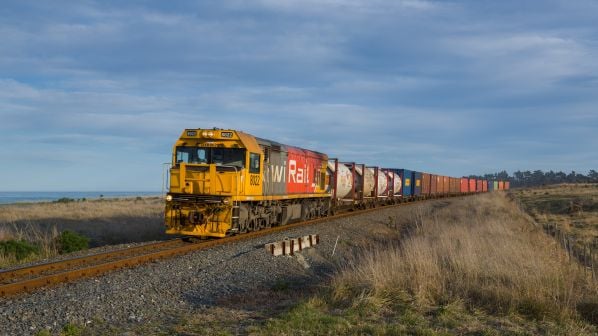NEW Zealand national railway KiwiRail has reported an improved surplus of $NZ 63.2m ($US 44.5m) for the 2021 financial year ending June 30, on the back of strong revenue growth in its domestic freight markets. This compares with a $NZ 40m surplus in the 2020 financial year. Revenue in 2021 increased by 7% to $NZ 681.6m.
The revenue growth came from most sectors says group chief executive, Mr Greg Miller. Domestic and export revenues increased with forestry freight revenue up 7% on the previous year, bulk freight up 11%, domestic up by 13%, and commercial vehicle freight on the Interislander ferry between the North and South islands up 2% compared with the 2020 financial year.
“Our container freight export revenue was on a par with the previous year, which reflects the ongoing turmoil in international supply chains caused by Covid-19,” Miller says.
“Closed borders continue to affect our tourism services, with a revenue fall from our three scenic passenger trains. We reduced the financial impact by tailoring our timetables, fares and schedules to match demand, and retained our people, but this remains a difficult environment for tourism operators. We know our scenery is as good as any other train trip in the world and we look forward to better days ahead.”
The government allocated $NZ 1.3bn to rail in the 2021 budget, on top of the $NZ 1.2bn allocated in 2020 and $NZ 1bn in 2019, which Miller says will prepare KiwiRail for a growth in freight as well as deliver an increase in skills and capacity required to implement the $NZ 4.5bn 10-year Rail Network Investment Programme.
“We have seen a roughly four-fold increase in our capital expenditure in the past five years with 2021 financial year capex of $NZ 1.05bn, compared with $NZ 257m in the 2016 financial year,” Miller says. A $NZ 8bn transformation of rail is underway and KiwiRail is growing its role as an essential and sustainable part of New Zealand’s supply chain.” Road freight operators are now among KiwiRail’s largest customers, and that business is growing as the benefits of rail are understood.
Miller says this investment is making the network more resilient and reliable, as part of a concerted strategy to enable more freight to move from road to rail, including increasing the loading gauge on the Whangārei - Swanson line to allow the transport of hi-cube containers.
Ageing rolling stock will also be replaced and improvements are being made to the Auckland and Wellington commuter networks, including the replacement of 130km of rail on the Auckland network following the discovery of rolling contact fatigue.
The new Te Huia commuter service between Hamilton and Auckland was launched during the financial year. KiwiRail also signed a $US 369m contract with Korean shipyard Hyundai Mipo Dockyard for the delivery of two new Cook Strait car and train ferries. The first ship will arrive in 2025 and the second in 2026.
New freight service
KiwiRail has also announced it will launch a new weekday rail freight service between Auckland and Christchurch, to support businesses grappling with disrupted ports and shipping lines. The NZ Connect service will boost capacity and connections to move domestic freight between the North and South islands.
“We are heading into the country’s busiest period for freight, from October through to March, a time when businesses look to restock ahead of Christmas and New Year when demand for products increases, and exports rise,” Miller says. “Shipping lines continue to struggle to offer certainty of capacity and delivery for the movement of freight between the islands. KiwiRail has identified this gap in the market so is stepping up to relieve some of these pressures by offering a faster and more certain domestic service than currently is available from shipping lines alone.”
The service will provide an additional 300 TEU in capacity daily.

